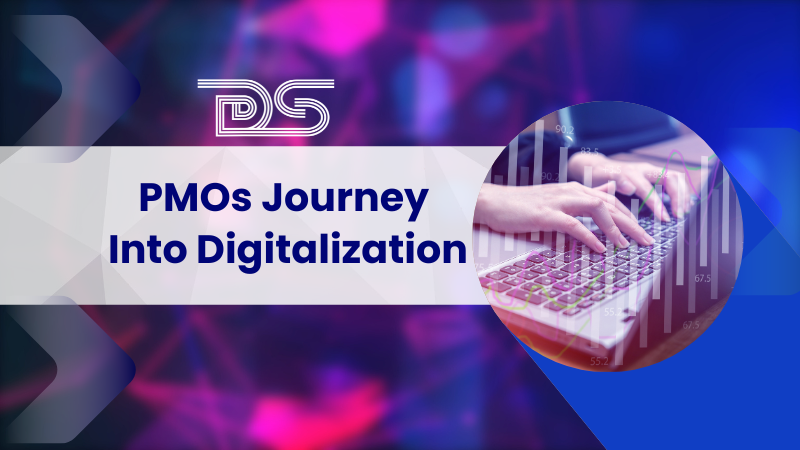
by admin | Jul 11, 2024 | General
Many PMOs recognize digitalization as an essential step in their organizations’ journey toward project management maturity. As a result, the Project Management Office (PMO) must shift its focus from project governance and delivery to supporting digital transformation.
To keep up with the evolving demands and needs of an increasingly digitized world, digital transformation has to be drifted through organizations of all shapes and sizes. However, many realize that successful digital transformation entails changing foundational cultures, structures, and methodologies and implementing digital tools. As organizations expand to accommodate this change, the PMO’s role within those organizations must change to do the same.
Digitalizing PMOs
Digital transformation is a familiar idea. Businesses constantly look for new ways to adapt and leverage emerging technologies to improve their business processes. Before the pandemic, PTC research found that 70% of organizations had or were working on a digital transformation strategy.
The PMO is crucial to achieving an organization’s strategic goals. If PMOs are to be an organization’s strategic drivers, they must expand their role beyond its traditional boundaries. They must assume their strategic role by leading change and capitalizing on opportunities in the digital space. PMOs must be at the forefront of emerging technologies, constantly evaluating opportunities and implementing new strategies. The recent pandemic and sudden shift to remote work have highlighted the challenges of developing community and culture through digital spaces. Here are some ways that PMOs can help the organization drive into digital transformation.
Five ways the PMO drives digital transformation
- PMOs can inspire and encourage change.
- PMOs act as the strategic arm
- PMOs provide support and insight.
- PMOs properly manage transformations.
- PMOs enable successful digital adoption.
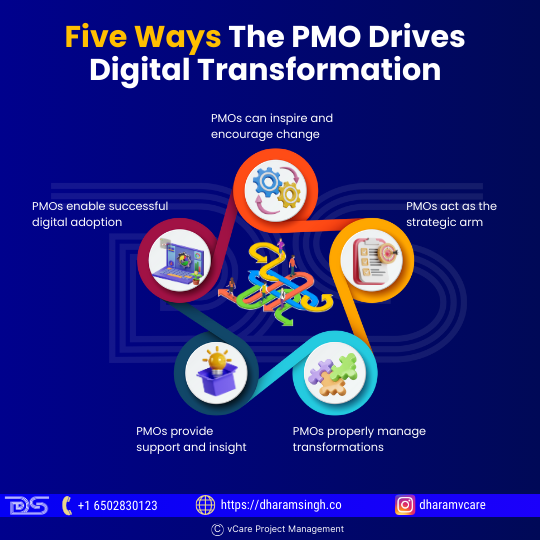
Five ways the PMO drives digital transformation
How PMOs can aid an organization’s digital transformation
The nature, ownership, and stakeholders of IT strategy, governance, and management activities are changing dramatically due to digitization. According to Gartner research, 87% of organizations prioritize digitization. Furthermore, technology is now responsible for 77% of an executive’s top priorities.
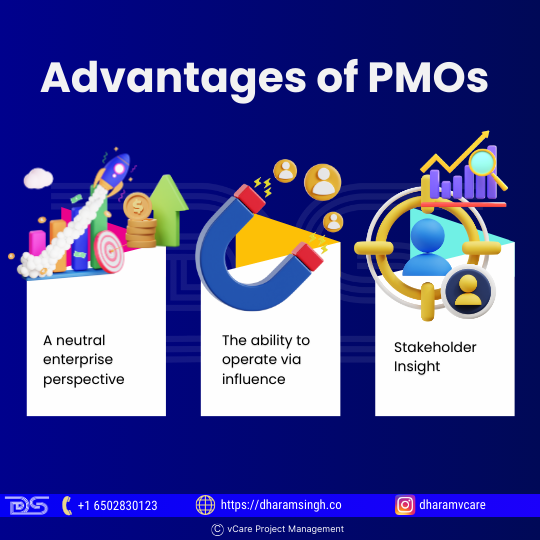
Advantages of PMOs
As a result, PMOs are under intense pressure to transform. Unfortunately, their project, program, and portfolio management processes are designed for predictability and consistency rather than the speed and flexibility required to meet digital demand. Most PMOs have three significant advantages, which are either inherent due to the PMO’s role or location or have been developed through previous experience:
- A neutral enterprise perspective: As capital allocation and portfolio prioritization approaches change to enable the funding flexibility required for digital work, the PMO’s impartial, enterprise-wide perspective on demand, investment, and resource utilization is hugely valuable.
- The ability to operate via influence: As organizational boundaries become more fluid and who “owns” project management becomes less certain, influencing and enabling others, rather than direct ownership, becomes even more critical.
- Stakeholder insight: As digitization spreads throughout the business and accounts for an increasing proportion of work, there are more first-time stakeholders and greater stakeholder complexity for each piece of work. Understanding the preferences of these various stakeholders and experiencing synthesizing their feedback becomes critical in delivering results from digital work.
Elements Driving Digitalization
Traditional businesses worldwide have long recognized that digital transformation is the key to thriving in a fast-paced world. Digital transformation involves integrating digital technology into all aspects of a business. It fundamentally alters how businesses operate and provide value to customers. It increases efficiency, transparency, customer experience, employee engagement, and culture and saves time and money. Modern digital tools have elevated the project management process to new heights.
The following are the seven critical elements of a successful strategic digital transformation framework:
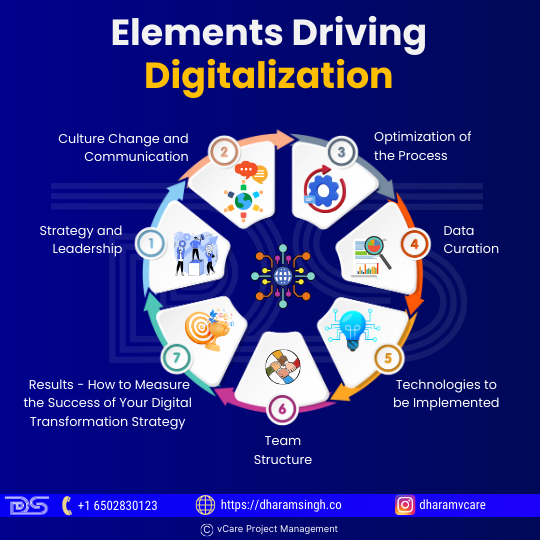
Elements Driving Digitalization
- Strategy and Leadership
An effective game plan is an obvious but frequently overlooked component of a digital transformation strategy. Instead, what matters is “how and who” formulates the strategy. A basic strategy and the appropriate technologies can help you digitize or digitalize your business, but transformation requires the right mindset and guidance. As a result, strategy combined with the right leadership is the first and most important component of an effective digital transformation strategy.
Visionary leadership combined with the appropriate digital transformation strategy can achieve a better, smoother, more cost-effective, and time-effective plan for your business’s transformation.
- Culture Change and Communication
Prepare for a massive cultural shift. A company’s clients and employees are typically resistant to significant changes, making implementing any transformation challenging. However, any successful digital transformation program must include culture. Therefore, giving your employees advanced training in good communication will be advantageous.
- Discuss the digital transformation strategy with your employees and how it will benefit all stakeholders.
- Conduct training sessions with your employees ahead of time to prepare them.
- You can prepare your employees by demonstrating the importance of aligning culture with new initiatives.
- Optimization of the Process
Every business has various processes and operations that can be improved to make workflows more efficient and effective. As a result, when developing a digital transformation strategy, consider business process optimization.
The strategy must optimize the business process while meeting customer and internal team goals. The digital transformation strategy must cover all interconnected business processes to achieve maximum output.
- Data Curation
One of the primary reasons for implementing digital transformation is to eliminate your business’s pain points for your team and your customers. But how will you know what these aches and pains are?
Data analysis and integration can assist you in locating them. People frequently choose their preferred technologies when developing transformation strategies before analyzing their data. Data analysis and the dissemination of its results can assist the team in identifying the best solutions to problems, leading to developing a better digital transformation strategy and making the most of the transformation process.
- Technologies to be Implemented
Finding the right technologies for your business is one of the most crucial steps in creating a digital transformation strategy. Introducing new technologies into your business will necessitate a significant financial investment, so it must be done correctly to avoid the need for additional funds. Any impactful strategy for digital transformation will always include options and budget constraints to help you make the best decision possible. Whether dealing with legacy system updates, application modernization, or implementing entirely new digital systems, you must find the best technology.
Some cutting-edge technologies that must be incorporated into your digital transformation strategy are:
- Cloud and Distributed Platforms
- Data Analytics & Artificial Intelligence
- Digital Experience and Digital Reality
- Team Structure
Harvard Business Review says digital transformation is about people, not tools. As a result, team structure is a determining factor in delivering results by the Digital Transformation Strategy.
The scope of the project should determine the team structure. The following components should be included in the digital transformation initiative:
- Pack of Leaders
- Business Experts
- The cast of Coders and Designers
- Results – How to Measure the Success of Your Digital Transformation Strategy
Your company’s digital transformation outcomes will greatly influence how you lay out your strategy. The outcomes will always vary depending on the practices and technologies used. Your digital transformation strategy’s success is dependent on its agility. First, of course, you must stick to your detailed strategy, but you must also be open to changes if things don’t go as planned.
By developing an effective, clear, and robust digital transformation strategy, you can ensure your company’s digital transformation goes as smoothly as possible. A digital transformation strategy is similar to a personalized road map for significant changes in your business operations. However, it requires significant financial investment, time, and technical expertise.
From Traditional PMO to Agile
Traditionally, PMOs have focused on maintaining project control to complete projects on time and within budget. However, in today’s increasingly complex and changing competitive environments, agile management is gradually displacing more traditional management methods; PMOs that remain anchored in this “classic” management model risk disappearing if they do not set the following objectives:
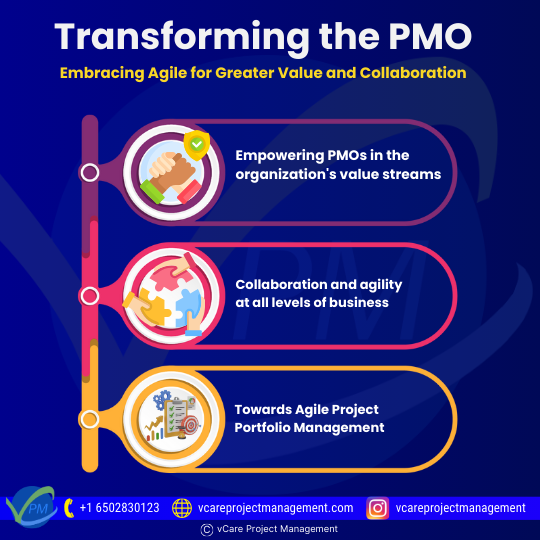
Transforming the PMO
- Empowering PMOs in the organization’s value streams
Organizations are now focusing on the value they provide to their customers and how different areas and departments contribute to that value creation. Suppose PMOs stick to their command and control model to ensure that projects are delivered on time and within budget. Their contribution to the organization’s value streams will be marginal, and senior management will view them as an unnecessary expense for the company.
- Collaboration and agility at all levels of business
Silo-based organizational models need to gain ground in agile and collaborative environments. As a result, PMOs must evolve beyond simply providing Project Managers with the tools they need to complete the organization’s projects.
On the one hand, PMOs must maintain open lines of communication with senior management to align the Project Portfolio with the organization’s goals. On the other hand, it serves as a reference point for stakeholders and project work teams, providing real-time information on project status and support at all levels for proper project implementation.
- Towards Agile Project Portfolio Management
Change is the norm in this new competitive environment, with highly volatile markets demanding businesses to bring products and services to market as quickly as possible. As a result, company objectives can shift dramatically quickly, necessitating a rethinking of project portfolio prioritization. This phase is where PMOs must adapt to this new environment and manage key project management issues like prioritization, resource management, budgets, or delivery dates in an agile manner, as well as learn to react to changes in their project portfolios in an agile and efficient way without losing sight of the organization’s objectives.
Post-pandemic challenges for PMO
If PMOs establish these three goals, they might avoid extinction because senior management will no longer recognize their value to the organization.
It will be challenging, and the Project Management Office will face several challenges as it adjusts to the new reality. In particular, the PMO will face some challenges for its role to be perceived as critical to the organization’s value streams:
- Coincide the project portfolio with the overall strategy of the organization.
- Resource management is a real challenge for PMOs.
- Responsiveness to changes in the project portfolio.
- Fluent in communication with the organization’s senior management.
- Embrace Agile Leadership.
- Standardization of processes and workflows.
- Renewal of project portfolio management tools.
Mitigating mediocre implementation of Programs
There are always equal chances of success and failure in programs/projects. As a result, it is critical to understand how to avoid and overcome project failure. There are numerous reasons why a PMO succeeds or fails. Still, the most common reasons for failure are often not related to process or technology issues but to “people issues” in an organization.
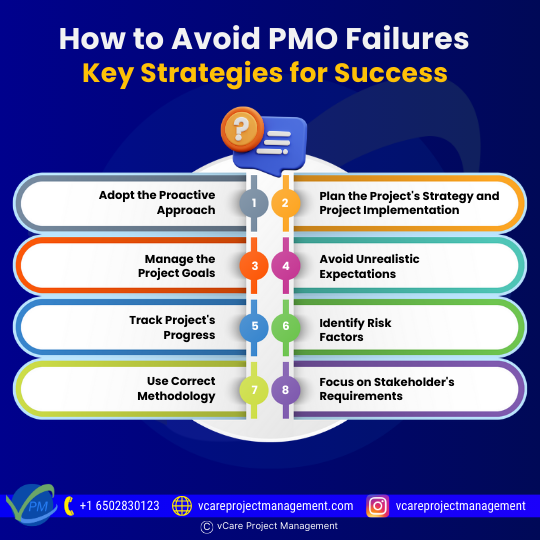
How to avoid PMO Failures
Here are the most common reasons why PMOs fail:
- Adopt the Proactive Approach
After many years, project managers gain the skills and knowledge needed for the current project from their experience. As a result, an experienced and highly skilled project manager is equipped to deal with customers and avoid project failure. If you are new to project management, consult a professional mentor to discuss your concerns and receive appropriate advice based on their experience. If you have project management experience, you should apply your skills and knowledge to the project and be aware of the common causes of project failure.
- Plan the Project’s Strategy and Project Implementation
The most important stage of any project is planning. Most of the time, proper attention is not given during the planning stage. If you plan properly, you will increase the project’s chances of success. After scheduling your project, use the Project Management Life Cycle to begin project execution.
- Manage the Project Goals
It would be best to document the project’s decisions, actions, and outcomes before beginning, during, and after completion. To avoid project failure, it is always necessary to ensure project deliverables and work appropriately with customer requirements. Never rely on understanding, verbal agreements, or memory for project implementation decisions.
- Avoid Unrealistic Expectations
Always set realistic expectations and time frames with stakeholders, team members, or customers to meet your project’s deadline. This move is related to the proper project start but goes deeper until completion. To avoid project failure, realistic expectations for team members must be set based on their capabilities. It would help if you encouraged them to work enthusiastically and push themselves beyond their comfort zone to meet the project’s objectives.
- Track Project’s Progress
Project planning will assist you in determining where your project should be now. In addition, you should know how much of the work has been completed, whether your work is on schedule, proceeding as planned, and so on. These three parameters govern any project and are critical in preventing project failure.
- Identify Risk Factors
The best way to avoid risk is to identify, analyze, and respond to risk factors. So, if you identify the risks and potential issues early on in the project, your project team can avoid them with appropriate actions. In addition, identifying and resolving risk factors will assist the project manager in lowering the likelihood of project failure. As a result, you can perform proper risk management and avoid project failure.
- Use Correct Methodology
One of the most important decisions a project manager must make is the methodology to use for project management. What you choose will have a significant impact on teamwork. However, each methodology has advantages and disadvantages depending on the project type and scope. Here are some top project management methodologies to consider.
- Waterfall method
- Agile/Scrum
- Hybrid approach
- Critical Chain Project Management
- Integrated Project Management Technique
- Critical Path Method (CPM)
All project management methodologies cannot be regarded as the best for all projects, so one can understand the project requirements and select the best option. The correct methodology will assist you in achieving the project goal within the specified time frame, thereby avoiding project failure.
- Focus on Stakeholder’s Requirements
As we all know, a project will only succeed if it meets its objectives and exceeds the expectations of its stakeholders. Therefore, to be successful in project management, all team members must be actively involved in the project and committed to its success. Devoting entails writing down the following stages:
- The competent initiative assists the team in implementing various tasks throughout the project life cycle.
- Adequate funding ensures the organization’s cost-generating department has enough money to fund the projects.
Final Thoughts
In today’s fast-paced and dynamic business environment, agile working methods might provide significant added value that should be noticed.
Digitalization is making projects more complex. As a result, the use of technology to manage projects is growing, and project teams must be cross-functional to achieve project goals. Agile project management provides an opportunity to respond quickly to new requirements and be more visible in the market. For organizations that use a traditional approach to project management, the transition to an agile PMO is part of their digital and agile transformation.
It should be noted that this is not an evaluation of “better” or “worse” methods. When used correctly, each project management method can reveal its strengths. It is critical to think about, use, and improve them.









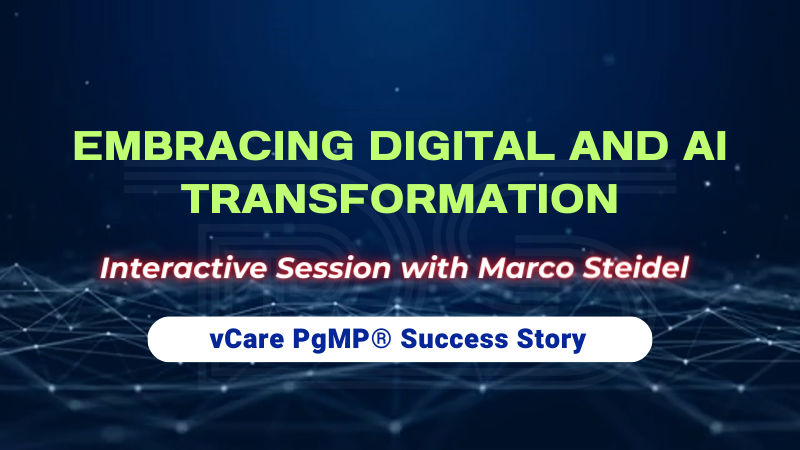

Recent Comments